ACNB: Analysis of Contract Law Principles and Case Studies
VerifiedAdded on 2020/02/05
|12
|3463
|59
Report
AI Summary
This report provides a comprehensive analysis of contract law, beginning with an introduction to the concept and its essential elements, such as intention, offer, acceptance, consideration, and capacity. It then categorizes contracts based on creation, execution, and enforceability, exploring express, implied, tacit, executed, executory, unilateral, bilateral, valid, void, and voidable contracts. The report delves into the terms of contracts, differentiating between express, implied, conditions, warranties, and innominate terms. The analysis extends to various scenarios, including offer and acceptance, breach of contract, and liability in tort. The report includes case studies to illustrate contract formation and breaches, providing a practical understanding of contract law principles and their application in real-world situations. The report also touches upon liability in torts, offering a broad understanding of the legal framework surrounding contracts.

ACNB
Paraphrase This Document
Need a fresh take? Get an instant paraphrase of this document with our AI Paraphraser
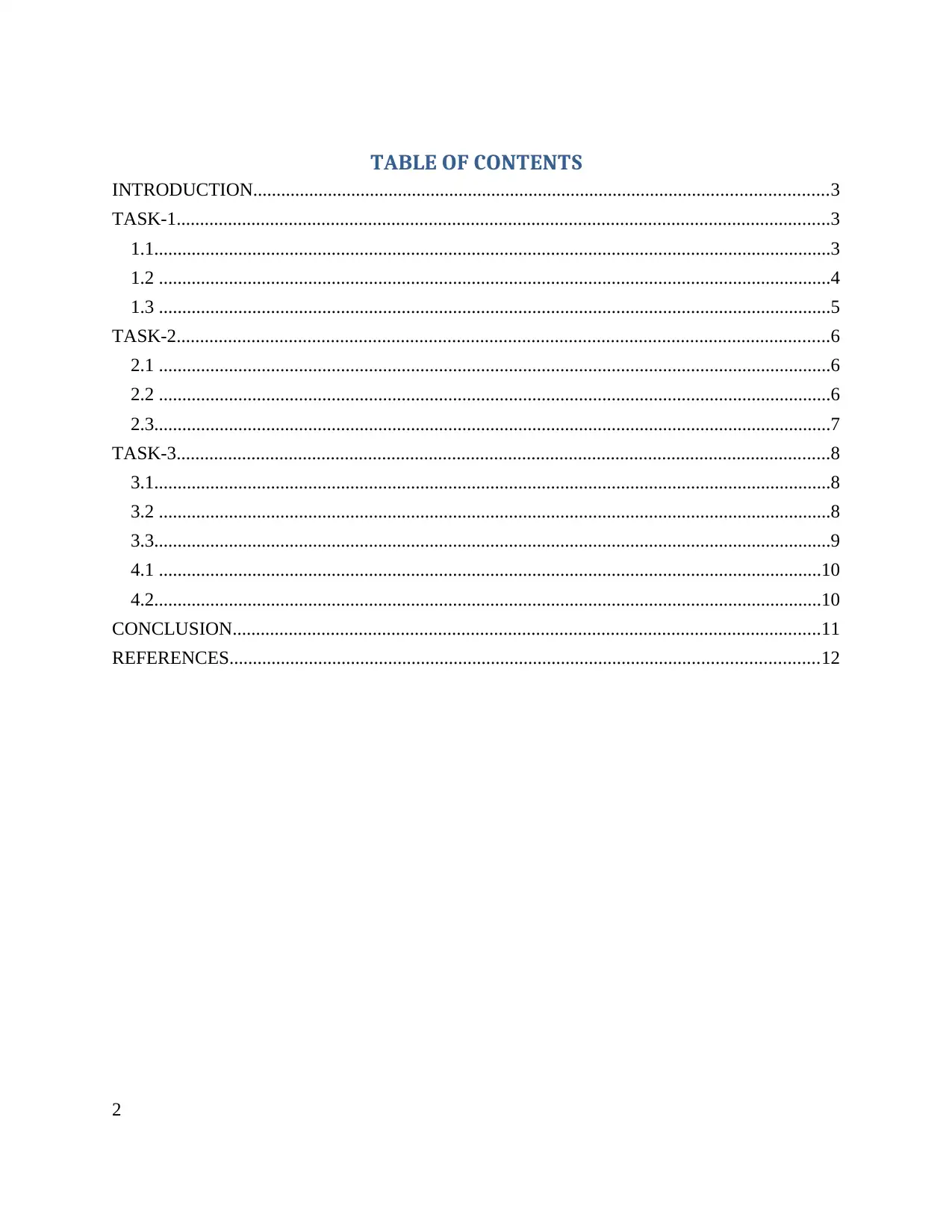
TABLE OF CONTENTS
INTRODUCTION...........................................................................................................................3
TASK-1............................................................................................................................................3
1.1.................................................................................................................................................3
1.2 ................................................................................................................................................4
1.3 ................................................................................................................................................5
TASK-2............................................................................................................................................6
2.1 ................................................................................................................................................6
2.2 ................................................................................................................................................6
2.3.................................................................................................................................................7
TASK-3............................................................................................................................................8
3.1.................................................................................................................................................8
3.2 ................................................................................................................................................8
3.3.................................................................................................................................................9
4.1 ..............................................................................................................................................10
4.2...............................................................................................................................................10
CONCLUSION..............................................................................................................................11
REFERENCES..............................................................................................................................12
2
INTRODUCTION...........................................................................................................................3
TASK-1............................................................................................................................................3
1.1.................................................................................................................................................3
1.2 ................................................................................................................................................4
1.3 ................................................................................................................................................5
TASK-2............................................................................................................................................6
2.1 ................................................................................................................................................6
2.2 ................................................................................................................................................6
2.3.................................................................................................................................................7
TASK-3............................................................................................................................................8
3.1.................................................................................................................................................8
3.2 ................................................................................................................................................8
3.3.................................................................................................................................................9
4.1 ..............................................................................................................................................10
4.2...............................................................................................................................................10
CONCLUSION..............................................................................................................................11
REFERENCES..............................................................................................................................12
2
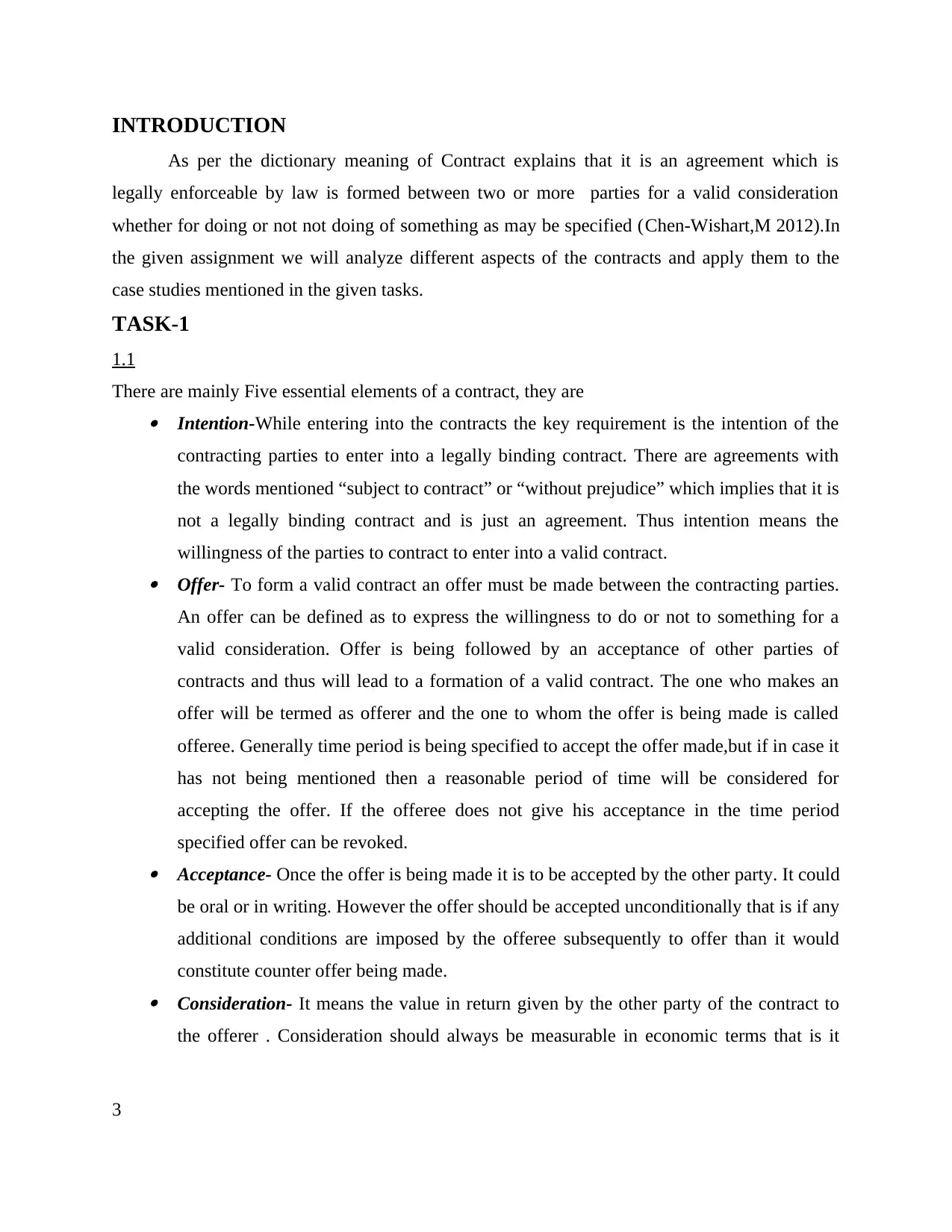
INTRODUCTION
As per the dictionary meaning of Contract explains that it is an agreement which is
legally enforceable by law is formed between two or more parties for a valid consideration
whether for doing or not not doing of something as may be specified (Chen-Wishart,M 2012).In
the given assignment we will analyze different aspects of the contracts and apply them to the
case studies mentioned in the given tasks.
TASK-1
1.1
There are mainly Five essential elements of a contract, they are Intention-While entering into the contracts the key requirement is the intention of the
contracting parties to enter into a legally binding contract. There are agreements with
the words mentioned “subject to contract” or “without prejudice” which implies that it is
not a legally binding contract and is just an agreement. Thus intention means the
willingness of the parties to contract to enter into a valid contract. Offer- To form a valid contract an offer must be made between the contracting parties.
An offer can be defined as to express the willingness to do or not to something for a
valid consideration. Offer is being followed by an acceptance of other parties of
contracts and thus will lead to a formation of a valid contract. The one who makes an
offer will be termed as offerer and the one to whom the offer is being made is called
offeree. Generally time period is being specified to accept the offer made,but if in case it
has not being mentioned then a reasonable period of time will be considered for
accepting the offer. If the offeree does not give his acceptance in the time period
specified offer can be revoked. Acceptance- Once the offer is being made it is to be accepted by the other party. It could
be oral or in writing. However the offer should be accepted unconditionally that is if any
additional conditions are imposed by the offeree subsequently to offer than it would
constitute counter offer being made. Consideration- It means the value in return given by the other party of the contract to
the offerer . Consideration should always be measurable in economic terms that is it
3
As per the dictionary meaning of Contract explains that it is an agreement which is
legally enforceable by law is formed between two or more parties for a valid consideration
whether for doing or not not doing of something as may be specified (Chen-Wishart,M 2012).In
the given assignment we will analyze different aspects of the contracts and apply them to the
case studies mentioned in the given tasks.
TASK-1
1.1
There are mainly Five essential elements of a contract, they are Intention-While entering into the contracts the key requirement is the intention of the
contracting parties to enter into a legally binding contract. There are agreements with
the words mentioned “subject to contract” or “without prejudice” which implies that it is
not a legally binding contract and is just an agreement. Thus intention means the
willingness of the parties to contract to enter into a valid contract. Offer- To form a valid contract an offer must be made between the contracting parties.
An offer can be defined as to express the willingness to do or not to something for a
valid consideration. Offer is being followed by an acceptance of other parties of
contracts and thus will lead to a formation of a valid contract. The one who makes an
offer will be termed as offerer and the one to whom the offer is being made is called
offeree. Generally time period is being specified to accept the offer made,but if in case it
has not being mentioned then a reasonable period of time will be considered for
accepting the offer. If the offeree does not give his acceptance in the time period
specified offer can be revoked. Acceptance- Once the offer is being made it is to be accepted by the other party. It could
be oral or in writing. However the offer should be accepted unconditionally that is if any
additional conditions are imposed by the offeree subsequently to offer than it would
constitute counter offer being made. Consideration- It means the value in return given by the other party of the contract to
the offerer . Consideration should always be measurable in economic terms that is it
3
⊘ This is a preview!⊘
Do you want full access?
Subscribe today to unlock all pages.

Trusted by 1+ million students worldwide
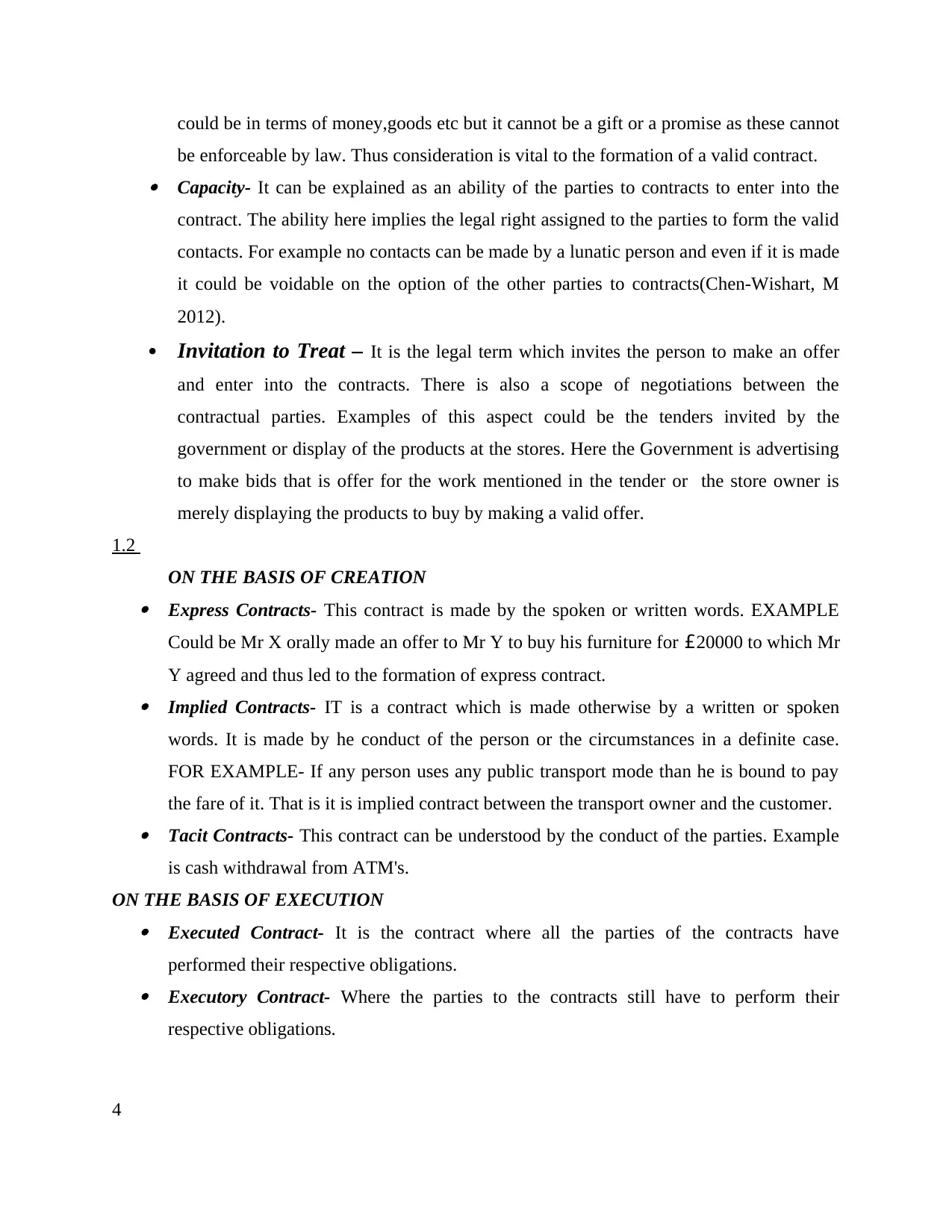
could be in terms of money,goods etc but it cannot be a gift or a promise as these cannot
be enforceable by law. Thus consideration is vital to the formation of a valid contract. Capacity- It can be explained as an ability of the parties to contracts to enter into the
contract. The ability here implies the legal right assigned to the parties to form the valid
contacts. For example no contacts can be made by a lunatic person and even if it is made
it could be voidable on the option of the other parties to contracts(Chen-Wishart, M
2012).
Invitation to Treat – It is the legal term which invites the person to make an offer
and enter into the contracts. There is also a scope of negotiations between the
contractual parties. Examples of this aspect could be the tenders invited by the
government or display of the products at the stores. Here the Government is advertising
to make bids that is offer for the work mentioned in the tender or the store owner is
merely displaying the products to buy by making a valid offer.
1.2
ON THE BASIS OF CREATION Express Contracts- This contract is made by the spoken or written words. EXAMPLE
Could be Mr X orally made an offer to Mr Y to buy his furniture for £20000 to which Mr
Y agreed and thus led to the formation of express contract. Implied Contracts- IT is a contract which is made otherwise by a written or spoken
words. It is made by he conduct of the person or the circumstances in a definite case.
FOR EXAMPLE- If any person uses any public transport mode than he is bound to pay
the fare of it. That is it is implied contract between the transport owner and the customer. Tacit Contracts- This contract can be understood by the conduct of the parties. Example
is cash withdrawal from ATM's.
ON THE BASIS OF EXECUTION Executed Contract- It is the contract where all the parties of the contracts have
performed their respective obligations. Executory Contract- Where the parties to the contracts still have to perform their
respective obligations.
4
be enforceable by law. Thus consideration is vital to the formation of a valid contract. Capacity- It can be explained as an ability of the parties to contracts to enter into the
contract. The ability here implies the legal right assigned to the parties to form the valid
contacts. For example no contacts can be made by a lunatic person and even if it is made
it could be voidable on the option of the other parties to contracts(Chen-Wishart, M
2012).
Invitation to Treat – It is the legal term which invites the person to make an offer
and enter into the contracts. There is also a scope of negotiations between the
contractual parties. Examples of this aspect could be the tenders invited by the
government or display of the products at the stores. Here the Government is advertising
to make bids that is offer for the work mentioned in the tender or the store owner is
merely displaying the products to buy by making a valid offer.
1.2
ON THE BASIS OF CREATION Express Contracts- This contract is made by the spoken or written words. EXAMPLE
Could be Mr X orally made an offer to Mr Y to buy his furniture for £20000 to which Mr
Y agreed and thus led to the formation of express contract. Implied Contracts- IT is a contract which is made otherwise by a written or spoken
words. It is made by he conduct of the person or the circumstances in a definite case.
FOR EXAMPLE- If any person uses any public transport mode than he is bound to pay
the fare of it. That is it is implied contract between the transport owner and the customer. Tacit Contracts- This contract can be understood by the conduct of the parties. Example
is cash withdrawal from ATM's.
ON THE BASIS OF EXECUTION Executed Contract- It is the contract where all the parties of the contracts have
performed their respective obligations. Executory Contract- Where the parties to the contracts still have to perform their
respective obligations.
4
Paraphrase This Document
Need a fresh take? Get an instant paraphrase of this document with our AI Paraphraser
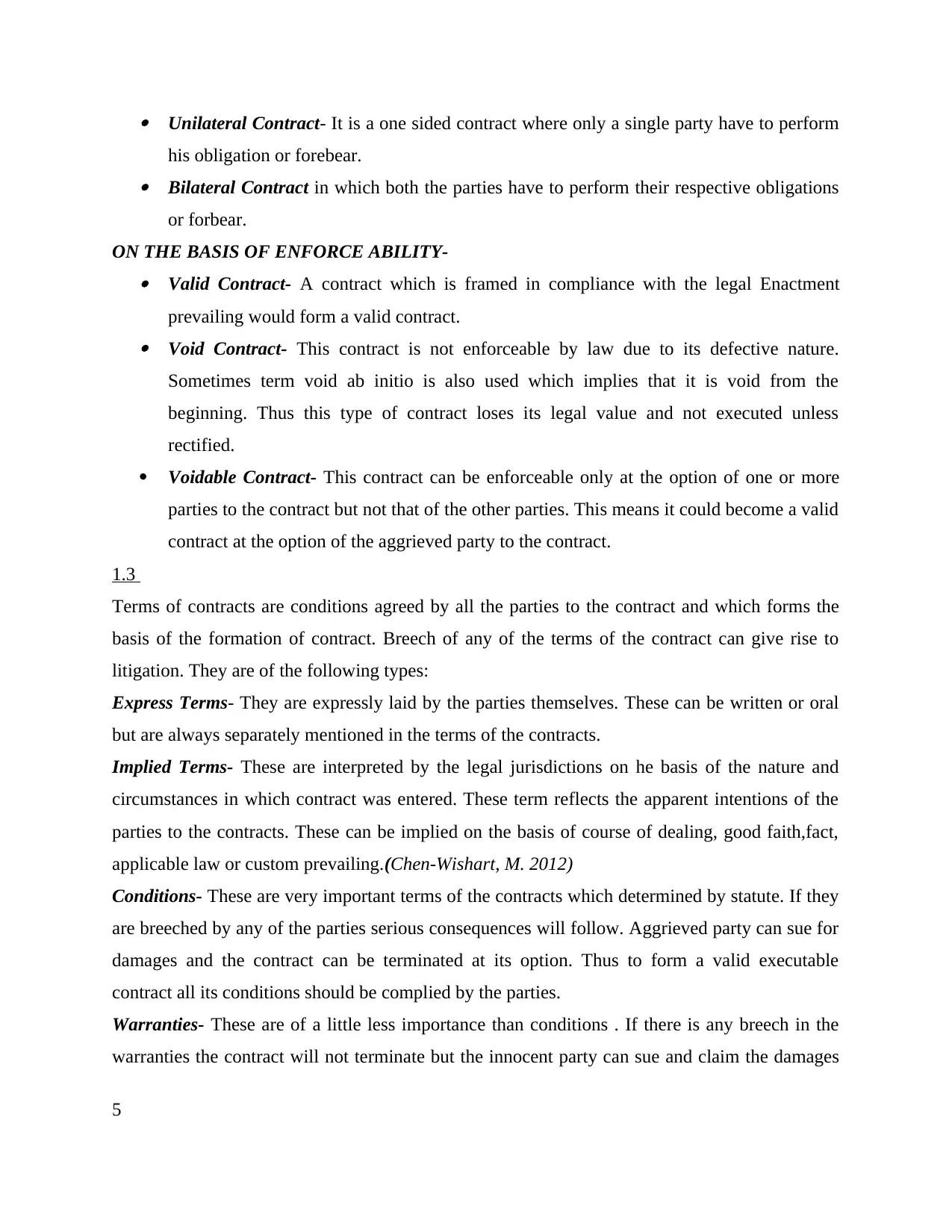
Unilateral Contract- It is a one sided contract where only a single party have to perform
his obligation or forebear. Bilateral Contract in which both the parties have to perform their respective obligations
or forbear.
ON THE BASIS OF ENFORCE ABILITY- Valid Contract- A contract which is framed in compliance with the legal Enactment
prevailing would form a valid contract. Void Contract- This contract is not enforceable by law due to its defective nature.
Sometimes term void ab initio is also used which implies that it is void from the
beginning. Thus this type of contract loses its legal value and not executed unless
rectified.
Voidable Contract- This contract can be enforceable only at the option of one or more
parties to the contract but not that of the other parties. This means it could become a valid
contract at the option of the aggrieved party to the contract.
1.3
Terms of contracts are conditions agreed by all the parties to the contract and which forms the
basis of the formation of contract. Breech of any of the terms of the contract can give rise to
litigation. They are of the following types:
Express Terms- They are expressly laid by the parties themselves. These can be written or oral
but are always separately mentioned in the terms of the contracts.
Implied Terms- These are interpreted by the legal jurisdictions on he basis of the nature and
circumstances in which contract was entered. These term reflects the apparent intentions of the
parties to the contracts. These can be implied on the basis of course of dealing, good faith,fact,
applicable law or custom prevailing.(Chen-Wishart, M. 2012)
Conditions- These are very important terms of the contracts which determined by statute. If they
are breeched by any of the parties serious consequences will follow. Aggrieved party can sue for
damages and the contract can be terminated at its option. Thus to form a valid executable
contract all its conditions should be complied by the parties.
Warranties- These are of a little less importance than conditions . If there is any breech in the
warranties the contract will not terminate but the innocent party can sue and claim the damages
5
his obligation or forebear. Bilateral Contract in which both the parties have to perform their respective obligations
or forbear.
ON THE BASIS OF ENFORCE ABILITY- Valid Contract- A contract which is framed in compliance with the legal Enactment
prevailing would form a valid contract. Void Contract- This contract is not enforceable by law due to its defective nature.
Sometimes term void ab initio is also used which implies that it is void from the
beginning. Thus this type of contract loses its legal value and not executed unless
rectified.
Voidable Contract- This contract can be enforceable only at the option of one or more
parties to the contract but not that of the other parties. This means it could become a valid
contract at the option of the aggrieved party to the contract.
1.3
Terms of contracts are conditions agreed by all the parties to the contract and which forms the
basis of the formation of contract. Breech of any of the terms of the contract can give rise to
litigation. They are of the following types:
Express Terms- They are expressly laid by the parties themselves. These can be written or oral
but are always separately mentioned in the terms of the contracts.
Implied Terms- These are interpreted by the legal jurisdictions on he basis of the nature and
circumstances in which contract was entered. These term reflects the apparent intentions of the
parties to the contracts. These can be implied on the basis of course of dealing, good faith,fact,
applicable law or custom prevailing.(Chen-Wishart, M. 2012)
Conditions- These are very important terms of the contracts which determined by statute. If they
are breeched by any of the parties serious consequences will follow. Aggrieved party can sue for
damages and the contract can be terminated at its option. Thus to form a valid executable
contract all its conditions should be complied by the parties.
Warranties- These are of a little less importance than conditions . If there is any breech in the
warranties the contract will not terminate but the innocent party can sue and claim the damages
5
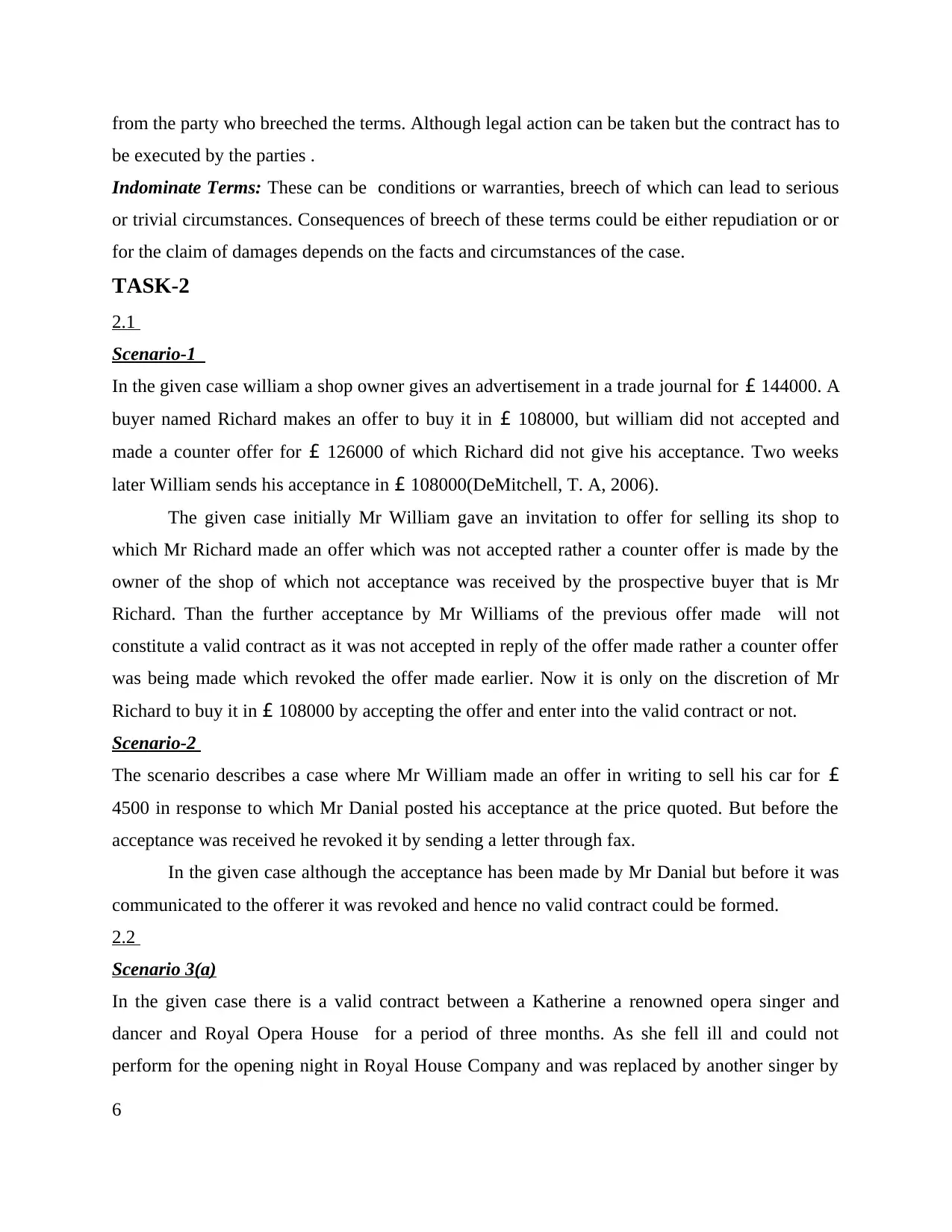
from the party who breeched the terms. Although legal action can be taken but the contract has to
be executed by the parties .
Indominate Terms: These can be conditions or warranties, breech of which can lead to serious
or trivial circumstances. Consequences of breech of these terms could be either repudiation or or
for the claim of damages depends on the facts and circumstances of the case.
TASK-2
2.1
Scenario-1
In the given case william a shop owner gives an advertisement in a trade journal for £ 144000. A
buyer named Richard makes an offer to buy it in £ 108000, but william did not accepted and
made a counter offer for £ 126000 of which Richard did not give his acceptance. Two weeks
later William sends his acceptance in £ 108000(DeMitchell, T. A, 2006).
The given case initially Mr William gave an invitation to offer for selling its shop to
which Mr Richard made an offer which was not accepted rather a counter offer is made by the
owner of the shop of which not acceptance was received by the prospective buyer that is Mr
Richard. Than the further acceptance by Mr Williams of the previous offer made will not
constitute a valid contract as it was not accepted in reply of the offer made rather a counter offer
was being made which revoked the offer made earlier. Now it is only on the discretion of Mr
Richard to buy it in £ 108000 by accepting the offer and enter into the valid contract or not.
Scenario-2
The scenario describes a case where Mr William made an offer in writing to sell his car for £
4500 in response to which Mr Danial posted his acceptance at the price quoted. But before the
acceptance was received he revoked it by sending a letter through fax.
In the given case although the acceptance has been made by Mr Danial but before it was
communicated to the offerer it was revoked and hence no valid contract could be formed.
2.2
Scenario 3(a)
In the given case there is a valid contract between a Katherine a renowned opera singer and
dancer and Royal Opera House for a period of three months. As she fell ill and could not
perform for the opening night in Royal House Company and was replaced by another singer by
6
be executed by the parties .
Indominate Terms: These can be conditions or warranties, breech of which can lead to serious
or trivial circumstances. Consequences of breech of these terms could be either repudiation or or
for the claim of damages depends on the facts and circumstances of the case.
TASK-2
2.1
Scenario-1
In the given case william a shop owner gives an advertisement in a trade journal for £ 144000. A
buyer named Richard makes an offer to buy it in £ 108000, but william did not accepted and
made a counter offer for £ 126000 of which Richard did not give his acceptance. Two weeks
later William sends his acceptance in £ 108000(DeMitchell, T. A, 2006).
The given case initially Mr William gave an invitation to offer for selling its shop to
which Mr Richard made an offer which was not accepted rather a counter offer is made by the
owner of the shop of which not acceptance was received by the prospective buyer that is Mr
Richard. Than the further acceptance by Mr Williams of the previous offer made will not
constitute a valid contract as it was not accepted in reply of the offer made rather a counter offer
was being made which revoked the offer made earlier. Now it is only on the discretion of Mr
Richard to buy it in £ 108000 by accepting the offer and enter into the valid contract or not.
Scenario-2
The scenario describes a case where Mr William made an offer in writing to sell his car for £
4500 in response to which Mr Danial posted his acceptance at the price quoted. But before the
acceptance was received he revoked it by sending a letter through fax.
In the given case although the acceptance has been made by Mr Danial but before it was
communicated to the offerer it was revoked and hence no valid contract could be formed.
2.2
Scenario 3(a)
In the given case there is a valid contract between a Katherine a renowned opera singer and
dancer and Royal Opera House for a period of three months. As she fell ill and could not
perform for the opening night in Royal House Company and was replaced by another singer by
6
⊘ This is a preview!⊘
Do you want full access?
Subscribe today to unlock all pages.

Trusted by 1+ million students worldwide
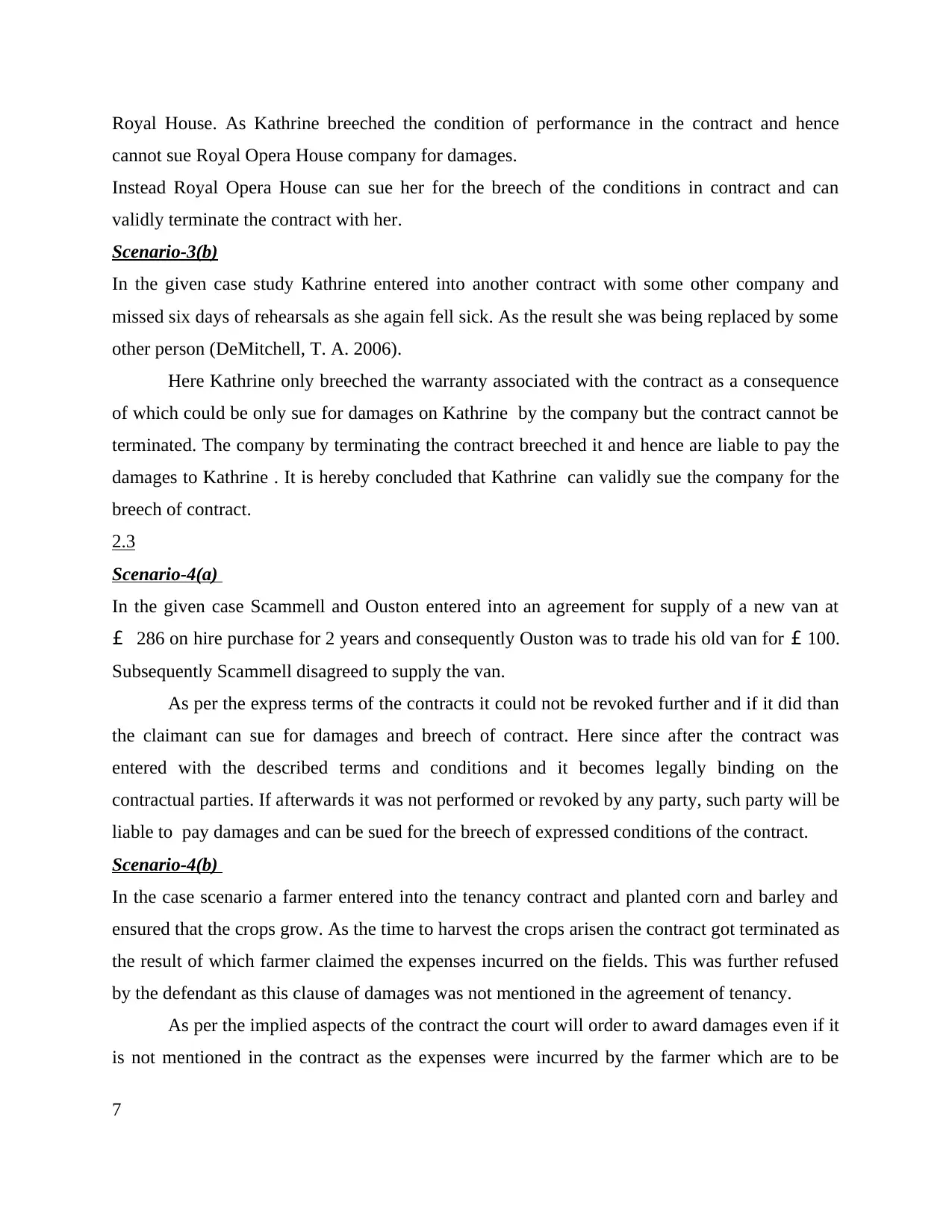
Royal House. As Kathrine breeched the condition of performance in the contract and hence
cannot sue Royal Opera House company for damages.
Instead Royal Opera House can sue her for the breech of the conditions in contract and can
validly terminate the contract with her.
Scenario-3(b)
In the given case study Kathrine entered into another contract with some other company and
missed six days of rehearsals as she again fell sick. As the result she was being replaced by some
other person (DeMitchell, T. A. 2006).
Here Kathrine only breeched the warranty associated with the contract as a consequence
of which could be only sue for damages on Kathrine by the company but the contract cannot be
terminated. The company by terminating the contract breeched it and hence are liable to pay the
damages to Kathrine . It is hereby concluded that Kathrine can validly sue the company for the
breech of contract.
2.3
Scenario-4(a)
In the given case Scammell and Ouston entered into an agreement for supply of a new van at
£ 286 on hire purchase for 2 years and consequently Ouston was to trade his old van for £ 100.
Subsequently Scammell disagreed to supply the van.
As per the express terms of the contracts it could not be revoked further and if it did than
the claimant can sue for damages and breech of contract. Here since after the contract was
entered with the described terms and conditions and it becomes legally binding on the
contractual parties. If afterwards it was not performed or revoked by any party, such party will be
liable to pay damages and can be sued for the breech of expressed conditions of the contract.
Scenario-4(b)
In the case scenario a farmer entered into the tenancy contract and planted corn and barley and
ensured that the crops grow. As the time to harvest the crops arisen the contract got terminated as
the result of which farmer claimed the expenses incurred on the fields. This was further refused
by the defendant as this clause of damages was not mentioned in the agreement of tenancy.
As per the implied aspects of the contract the court will order to award damages even if it
is not mentioned in the contract as the expenses were incurred by the farmer which are to be
7
cannot sue Royal Opera House company for damages.
Instead Royal Opera House can sue her for the breech of the conditions in contract and can
validly terminate the contract with her.
Scenario-3(b)
In the given case study Kathrine entered into another contract with some other company and
missed six days of rehearsals as she again fell sick. As the result she was being replaced by some
other person (DeMitchell, T. A. 2006).
Here Kathrine only breeched the warranty associated with the contract as a consequence
of which could be only sue for damages on Kathrine by the company but the contract cannot be
terminated. The company by terminating the contract breeched it and hence are liable to pay the
damages to Kathrine . It is hereby concluded that Kathrine can validly sue the company for the
breech of contract.
2.3
Scenario-4(a)
In the given case Scammell and Ouston entered into an agreement for supply of a new van at
£ 286 on hire purchase for 2 years and consequently Ouston was to trade his old van for £ 100.
Subsequently Scammell disagreed to supply the van.
As per the express terms of the contracts it could not be revoked further and if it did than
the claimant can sue for damages and breech of contract. Here since after the contract was
entered with the described terms and conditions and it becomes legally binding on the
contractual parties. If afterwards it was not performed or revoked by any party, such party will be
liable to pay damages and can be sued for the breech of expressed conditions of the contract.
Scenario-4(b)
In the case scenario a farmer entered into the tenancy contract and planted corn and barley and
ensured that the crops grow. As the time to harvest the crops arisen the contract got terminated as
the result of which farmer claimed the expenses incurred on the fields. This was further refused
by the defendant as this clause of damages was not mentioned in the agreement of tenancy.
As per the implied aspects of the contract the court will order to award damages even if it
is not mentioned in the contract as the expenses were incurred by the farmer which are to be
7
Paraphrase This Document
Need a fresh take? Get an instant paraphrase of this document with our AI Paraphraser
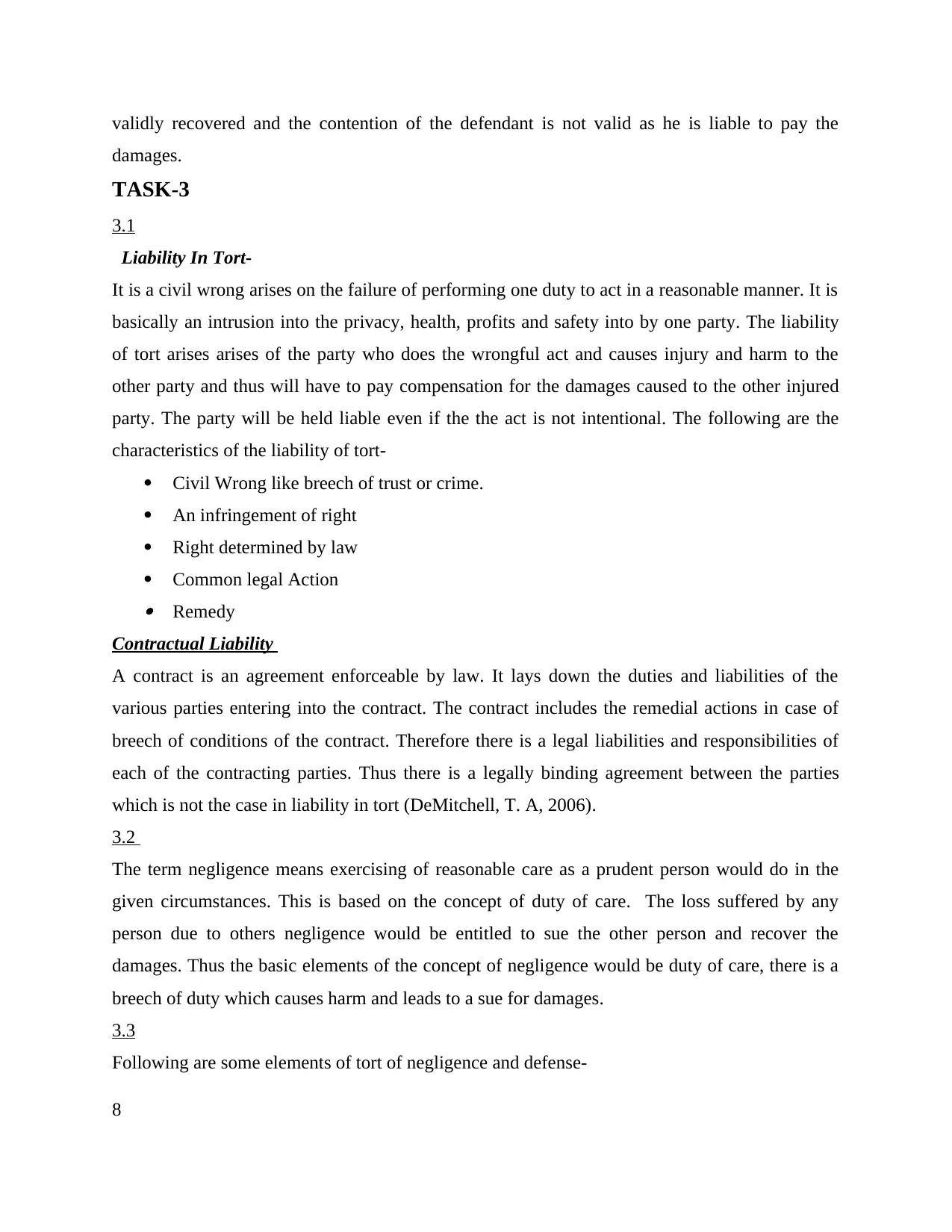
validly recovered and the contention of the defendant is not valid as he is liable to pay the
damages.
TASK-3
3.1
Liability In Tort-
It is a civil wrong arises on the failure of performing one duty to act in a reasonable manner. It is
basically an intrusion into the privacy, health, profits and safety into by one party. The liability
of tort arises arises of the party who does the wrongful act and causes injury and harm to the
other party and thus will have to pay compensation for the damages caused to the other injured
party. The party will be held liable even if the the act is not intentional. The following are the
characteristics of the liability of tort-
Civil Wrong like breech of trust or crime.
An infringement of right
Right determined by law
Common legal Action Remedy
Contractual Liability
A contract is an agreement enforceable by law. It lays down the duties and liabilities of the
various parties entering into the contract. The contract includes the remedial actions in case of
breech of conditions of the contract. Therefore there is a legal liabilities and responsibilities of
each of the contracting parties. Thus there is a legally binding agreement between the parties
which is not the case in liability in tort (DeMitchell, T. A, 2006).
3.2
The term negligence means exercising of reasonable care as a prudent person would do in the
given circumstances. This is based on the concept of duty of care. The loss suffered by any
person due to others negligence would be entitled to sue the other person and recover the
damages. Thus the basic elements of the concept of negligence would be duty of care, there is a
breech of duty which causes harm and leads to a sue for damages.
3.3
Following are some elements of tort of negligence and defense-
8
damages.
TASK-3
3.1
Liability In Tort-
It is a civil wrong arises on the failure of performing one duty to act in a reasonable manner. It is
basically an intrusion into the privacy, health, profits and safety into by one party. The liability
of tort arises arises of the party who does the wrongful act and causes injury and harm to the
other party and thus will have to pay compensation for the damages caused to the other injured
party. The party will be held liable even if the the act is not intentional. The following are the
characteristics of the liability of tort-
Civil Wrong like breech of trust or crime.
An infringement of right
Right determined by law
Common legal Action Remedy
Contractual Liability
A contract is an agreement enforceable by law. It lays down the duties and liabilities of the
various parties entering into the contract. The contract includes the remedial actions in case of
breech of conditions of the contract. Therefore there is a legal liabilities and responsibilities of
each of the contracting parties. Thus there is a legally binding agreement between the parties
which is not the case in liability in tort (DeMitchell, T. A, 2006).
3.2
The term negligence means exercising of reasonable care as a prudent person would do in the
given circumstances. This is based on the concept of duty of care. The loss suffered by any
person due to others negligence would be entitled to sue the other person and recover the
damages. Thus the basic elements of the concept of negligence would be duty of care, there is a
breech of duty which causes harm and leads to a sue for damages.
3.3
Following are some elements of tort of negligence and defense-
8
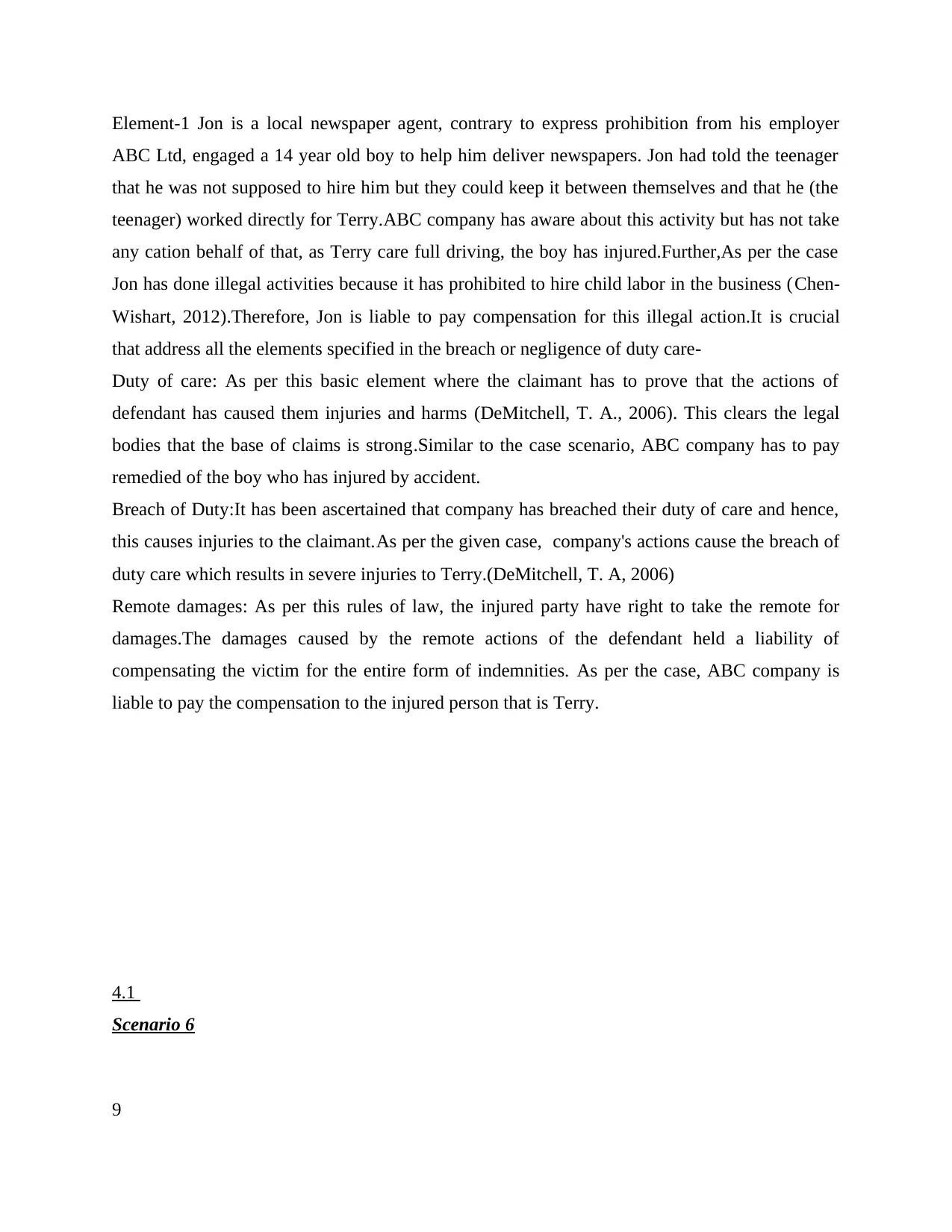
Element-1 Jon is a local newspaper agent, contrary to express prohibition from his employer
ABC Ltd, engaged a 14 year old boy to help him deliver newspapers. Jon had told the teenager
that he was not supposed to hire him but they could keep it between themselves and that he (the
teenager) worked directly for Terry.ABC company has aware about this activity but has not take
any cation behalf of that, as Terry care full driving, the boy has injured.Further,As per the case
Jon has done illegal activities because it has prohibited to hire child labor in the business (Chen-
Wishart, 2012).Therefore, Jon is liable to pay compensation for this illegal action.It is crucial
that address all the elements specified in the breach or negligence of duty care-
Duty of care: As per this basic element where the claimant has to prove that the actions of
defendant has caused them injuries and harms (DeMitchell, T. A., 2006). This clears the legal
bodies that the base of claims is strong.Similar to the case scenario, ABC company has to pay
remedied of the boy who has injured by accident.
Breach of Duty:It has been ascertained that company has breached their duty of care and hence,
this causes injuries to the claimant.As per the given case, company's actions cause the breach of
duty care which results in severe injuries to Terry.(DeMitchell, T. A, 2006)
Remote damages: As per this rules of law, the injured party have right to take the remote for
damages.The damages caused by the remote actions of the defendant held a liability of
compensating the victim for the entire form of indemnities. As per the case, ABC company is
liable to pay the compensation to the injured person that is Terry.
4.1
Scenario 6
9
ABC Ltd, engaged a 14 year old boy to help him deliver newspapers. Jon had told the teenager
that he was not supposed to hire him but they could keep it between themselves and that he (the
teenager) worked directly for Terry.ABC company has aware about this activity but has not take
any cation behalf of that, as Terry care full driving, the boy has injured.Further,As per the case
Jon has done illegal activities because it has prohibited to hire child labor in the business (Chen-
Wishart, 2012).Therefore, Jon is liable to pay compensation for this illegal action.It is crucial
that address all the elements specified in the breach or negligence of duty care-
Duty of care: As per this basic element where the claimant has to prove that the actions of
defendant has caused them injuries and harms (DeMitchell, T. A., 2006). This clears the legal
bodies that the base of claims is strong.Similar to the case scenario, ABC company has to pay
remedied of the boy who has injured by accident.
Breach of Duty:It has been ascertained that company has breached their duty of care and hence,
this causes injuries to the claimant.As per the given case, company's actions cause the breach of
duty care which results in severe injuries to Terry.(DeMitchell, T. A, 2006)
Remote damages: As per this rules of law, the injured party have right to take the remote for
damages.The damages caused by the remote actions of the defendant held a liability of
compensating the victim for the entire form of indemnities. As per the case, ABC company is
liable to pay the compensation to the injured person that is Terry.
4.1
Scenario 6
9
⊘ This is a preview!⊘
Do you want full access?
Subscribe today to unlock all pages.

Trusted by 1+ million students worldwide
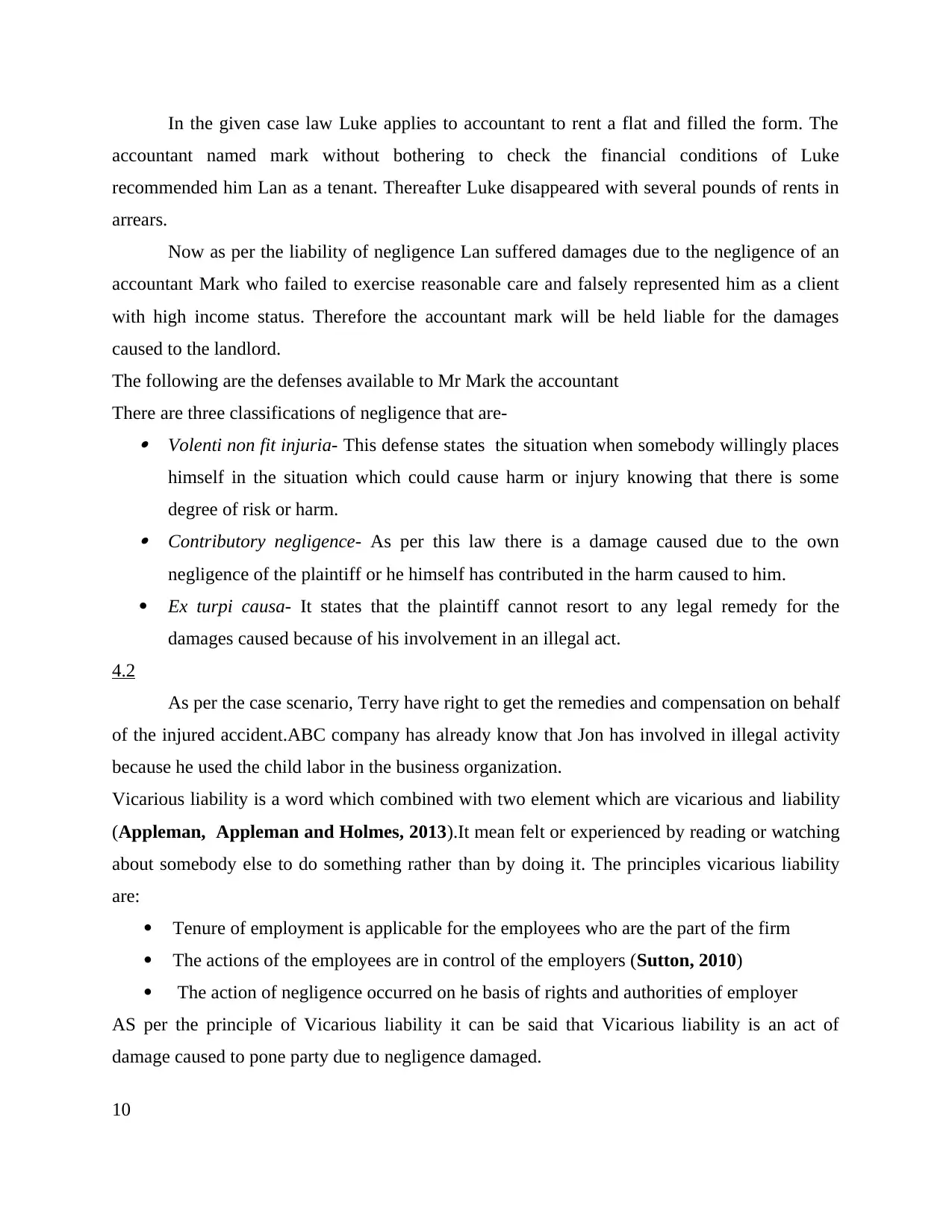
In the given case law Luke applies to accountant to rent a flat and filled the form. The
accountant named mark without bothering to check the financial conditions of Luke
recommended him Lan as a tenant. Thereafter Luke disappeared with several pounds of rents in
arrears.
Now as per the liability of negligence Lan suffered damages due to the negligence of an
accountant Mark who failed to exercise reasonable care and falsely represented him as a client
with high income status. Therefore the accountant mark will be held liable for the damages
caused to the landlord.
The following are the defenses available to Mr Mark the accountant
There are three classifications of negligence that are- Volenti non fit injuria- This defense states the situation when somebody willingly places
himself in the situation which could cause harm or injury knowing that there is some
degree of risk or harm. Contributory negligence- As per this law there is a damage caused due to the own
negligence of the plaintiff or he himself has contributed in the harm caused to him.
Ex turpi causa- It states that the plaintiff cannot resort to any legal remedy for the
damages caused because of his involvement in an illegal act.
4.2
As per the case scenario, Terry have right to get the remedies and compensation on behalf
of the injured accident.ABC company has already know that Jon has involved in illegal activity
because he used the child labor in the business organization.
Vicarious liability is a word which combined with two element which are vicarious and liability
(Appleman, Appleman and Holmes, 2013).It mean felt or experienced by reading or watching
about somebody else to do something rather than by doing it. The principles vicarious liability
are:
Tenure of employment is applicable for the employees who are the part of the firm
The actions of the employees are in control of the employers (Sutton, 2010)
The action of negligence occurred on he basis of rights and authorities of employer
AS per the principle of Vicarious liability it can be said that Vicarious liability is an act of
damage caused to pone party due to negligence damaged.
10
accountant named mark without bothering to check the financial conditions of Luke
recommended him Lan as a tenant. Thereafter Luke disappeared with several pounds of rents in
arrears.
Now as per the liability of negligence Lan suffered damages due to the negligence of an
accountant Mark who failed to exercise reasonable care and falsely represented him as a client
with high income status. Therefore the accountant mark will be held liable for the damages
caused to the landlord.
The following are the defenses available to Mr Mark the accountant
There are three classifications of negligence that are- Volenti non fit injuria- This defense states the situation when somebody willingly places
himself in the situation which could cause harm or injury knowing that there is some
degree of risk or harm. Contributory negligence- As per this law there is a damage caused due to the own
negligence of the plaintiff or he himself has contributed in the harm caused to him.
Ex turpi causa- It states that the plaintiff cannot resort to any legal remedy for the
damages caused because of his involvement in an illegal act.
4.2
As per the case scenario, Terry have right to get the remedies and compensation on behalf
of the injured accident.ABC company has already know that Jon has involved in illegal activity
because he used the child labor in the business organization.
Vicarious liability is a word which combined with two element which are vicarious and liability
(Appleman, Appleman and Holmes, 2013).It mean felt or experienced by reading or watching
about somebody else to do something rather than by doing it. The principles vicarious liability
are:
Tenure of employment is applicable for the employees who are the part of the firm
The actions of the employees are in control of the employers (Sutton, 2010)
The action of negligence occurred on he basis of rights and authorities of employer
AS per the principle of Vicarious liability it can be said that Vicarious liability is an act of
damage caused to pone party due to negligence damaged.
10
Paraphrase This Document
Need a fresh take? Get an instant paraphrase of this document with our AI Paraphraser
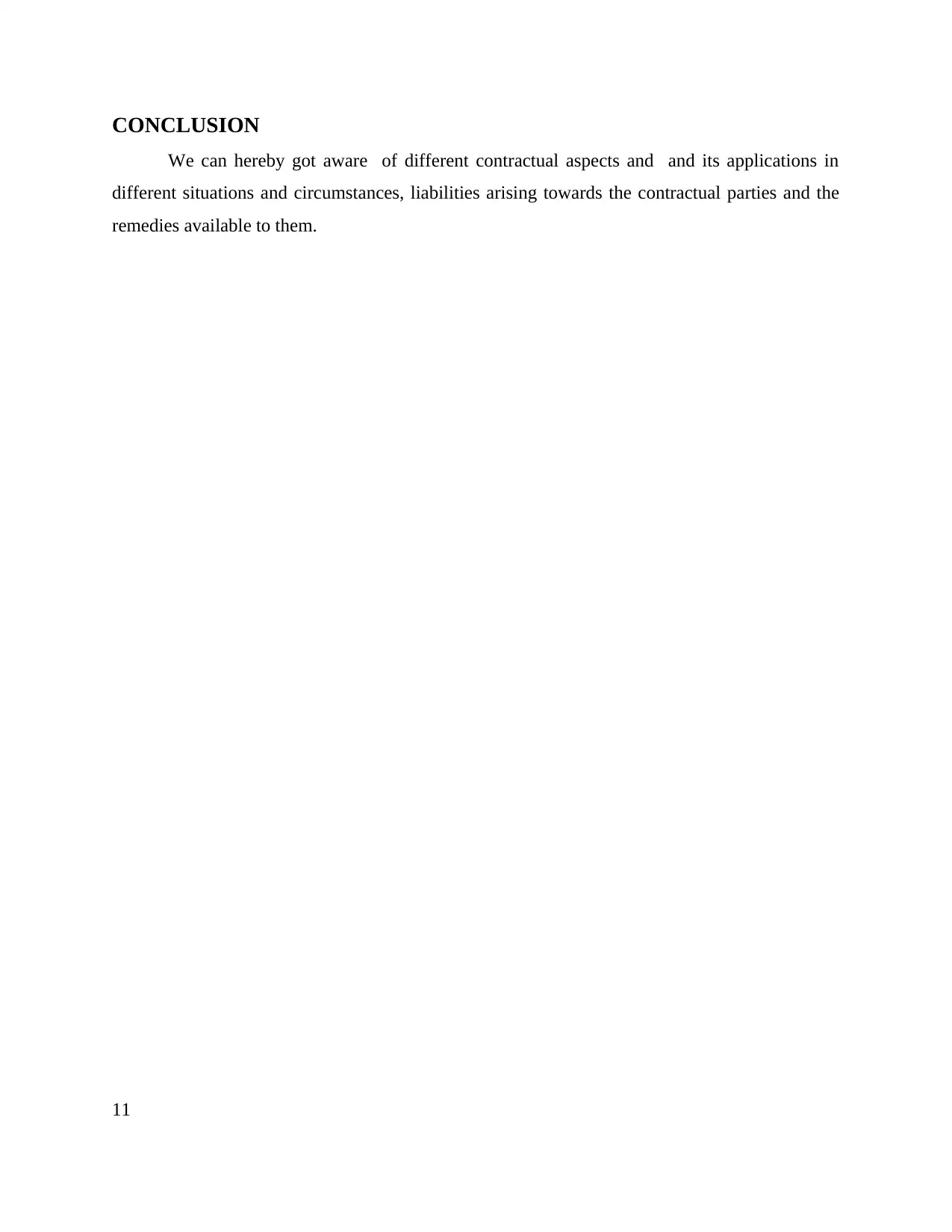
CONCLUSION
We can hereby got aware of different contractual aspects and and its applications in
different situations and circumstances, liabilities arising towards the contractual parties and the
remedies available to them.
11
We can hereby got aware of different contractual aspects and and its applications in
different situations and circumstances, liabilities arising towards the contractual parties and the
remedies available to them.
11
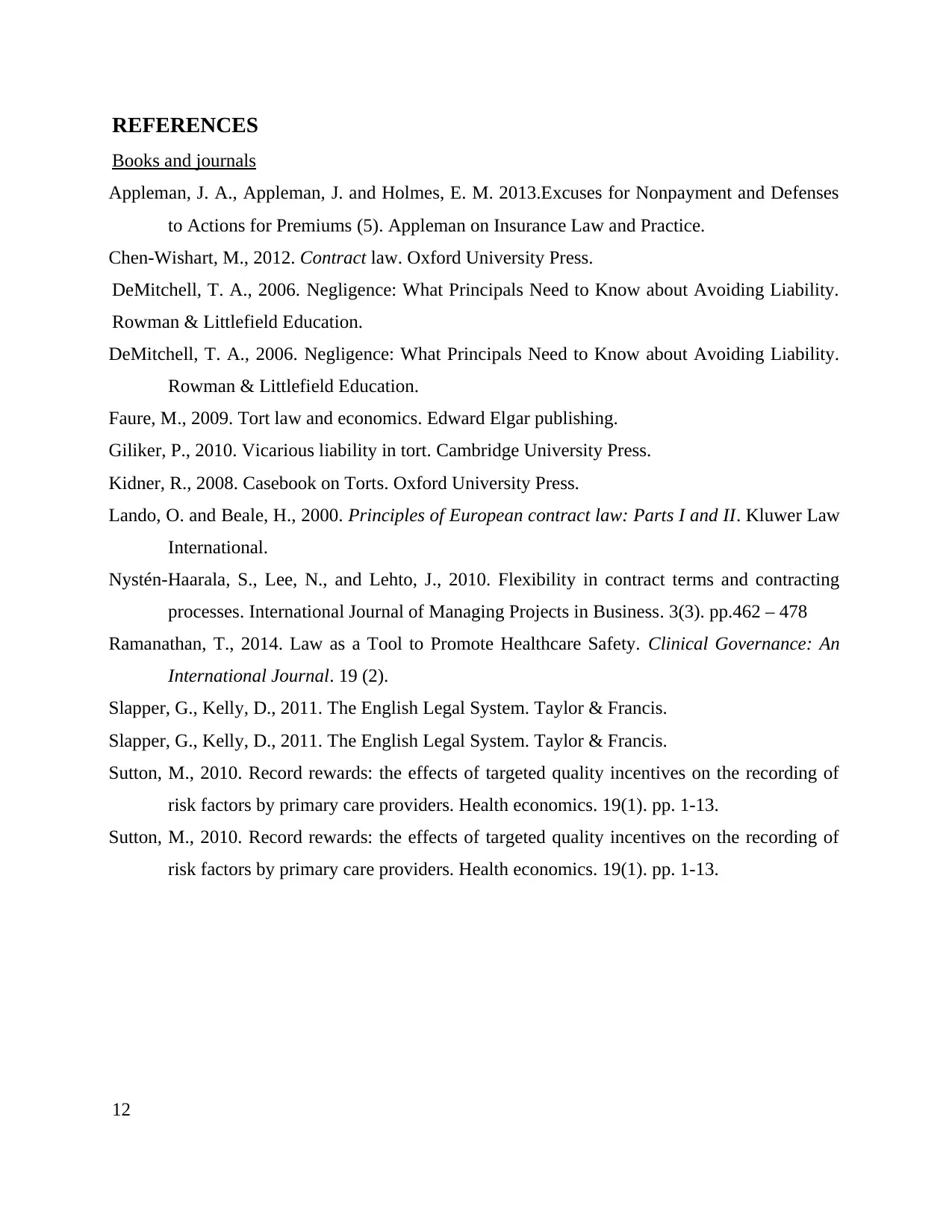
REFERENCES
Books and journals
Appleman, J. A., Appleman, J. and Holmes, E. M. 2013.Excuses for Nonpayment and Defenses
to Actions for Premiums (5). Appleman on Insurance Law and Practice.
Chen-Wishart, M., 2012. Contract law. Oxford University Press.
DeMitchell, T. A., 2006. Negligence: What Principals Need to Know about Avoiding Liability.
Rowman & Littlefield Education.
DeMitchell, T. A., 2006. Negligence: What Principals Need to Know about Avoiding Liability.
Rowman & Littlefield Education.
Faure, M., 2009. Tort law and economics. Edward Elgar publishing.
Giliker, P., 2010. Vicarious liability in tort. Cambridge University Press.
Kidner, R., 2008. Casebook on Torts. Oxford University Press.
Lando, O. and Beale, H., 2000. Principles of European contract law: Parts I and II. Kluwer Law
International.
Nystén-Haarala, S., Lee, N., and Lehto, J., 2010. Flexibility in contract terms and contracting
processes. International Journal of Managing Projects in Business. 3(3). pp.462 – 478
Ramanathan, T., 2014. Law as a Tool to Promote Healthcare Safety. Clinical Governance: An
International Journal. 19 (2).
Slapper, G., Kelly, D., 2011. The English Legal System. Taylor & Francis.
Slapper, G., Kelly, D., 2011. The English Legal System. Taylor & Francis.
Sutton, M., 2010. Record rewards: the effects of targeted quality incentives on the recording of
risk factors by primary care providers. Health economics. 19(1). pp. 1-13.
Sutton, M., 2010. Record rewards: the effects of targeted quality incentives on the recording of
risk factors by primary care providers. Health economics. 19(1). pp. 1-13.
12
Books and journals
Appleman, J. A., Appleman, J. and Holmes, E. M. 2013.Excuses for Nonpayment and Defenses
to Actions for Premiums (5). Appleman on Insurance Law and Practice.
Chen-Wishart, M., 2012. Contract law. Oxford University Press.
DeMitchell, T. A., 2006. Negligence: What Principals Need to Know about Avoiding Liability.
Rowman & Littlefield Education.
DeMitchell, T. A., 2006. Negligence: What Principals Need to Know about Avoiding Liability.
Rowman & Littlefield Education.
Faure, M., 2009. Tort law and economics. Edward Elgar publishing.
Giliker, P., 2010. Vicarious liability in tort. Cambridge University Press.
Kidner, R., 2008. Casebook on Torts. Oxford University Press.
Lando, O. and Beale, H., 2000. Principles of European contract law: Parts I and II. Kluwer Law
International.
Nystén-Haarala, S., Lee, N., and Lehto, J., 2010. Flexibility in contract terms and contracting
processes. International Journal of Managing Projects in Business. 3(3). pp.462 – 478
Ramanathan, T., 2014. Law as a Tool to Promote Healthcare Safety. Clinical Governance: An
International Journal. 19 (2).
Slapper, G., Kelly, D., 2011. The English Legal System. Taylor & Francis.
Slapper, G., Kelly, D., 2011. The English Legal System. Taylor & Francis.
Sutton, M., 2010. Record rewards: the effects of targeted quality incentives on the recording of
risk factors by primary care providers. Health economics. 19(1). pp. 1-13.
Sutton, M., 2010. Record rewards: the effects of targeted quality incentives on the recording of
risk factors by primary care providers. Health economics. 19(1). pp. 1-13.
12
⊘ This is a preview!⊘
Do you want full access?
Subscribe today to unlock all pages.

Trusted by 1+ million students worldwide
1 out of 12
Related Documents
Your All-in-One AI-Powered Toolkit for Academic Success.
+13062052269
info@desklib.com
Available 24*7 on WhatsApp / Email
![[object Object]](/_next/static/media/star-bottom.7253800d.svg)
Unlock your academic potential
Copyright © 2020–2025 A2Z Services. All Rights Reserved. Developed and managed by ZUCOL.





